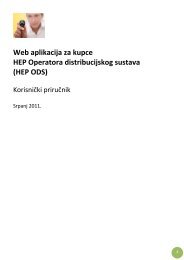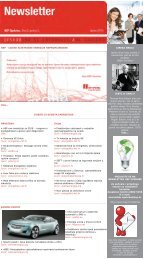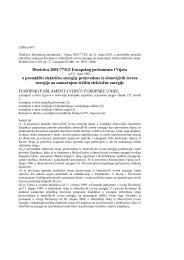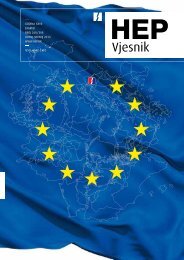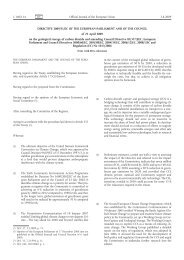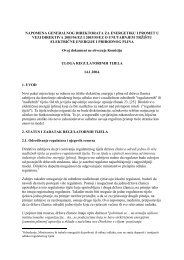Untitled
Untitled
Untitled
You also want an ePaper? Increase the reach of your titles
YUMPU automatically turns print PDFs into web optimized ePapers that Google loves.
Na spomenuti kontekst ulaganja u odræavanje,rekonstrukciju i izgradnju nacionalnih elektroenergetskihmreæa, odnosno izgradnje novih visokonaponskihprijenosnih prekograniËnih poveznicas drugim zemljama i sustavima sve vaænijiutjecaj ima regionalni i πiri multinacionalni konteksttræiπta i razmjena elektriËne energije. OpÊaje pojava da prekograniËna trgovanja i razmjeneenergije vrlo brzo rastu, zbog Ëega su za tranzitei prekograniËne razmjene energije uvedeni i primjenjujuse novi opÊe prihvaÊeni kompenzacijskii alokacijski mehanizmi. Isti se veÊ jednoznaËnoprimjenjuju u kontekstu internog europskog træiπtaelektriËne energije. Nadalje, prihodi ostvareniprekograniËnim razmjenama moraju se tretiratina razvidan i nepristran naËin. Meappleutim, unatoËnastojanju da se razvije i uspostavi efikasan, razvidan,nepristran i pravedan, u konaËnici i lakoprovediv sustav i mehanizam, za neke elektroenergetskesustave i nadalje ostaje problem naËinautvrappleivanja i alokacije troπkova za visoke gubitkeelektriËne energije. Isto vrijedi i u pogledu adekvatnogdijela pomoÊnih usluga sustava. Naime,radi se o onom dijelu dodatnih gubitaka elektriËneenergije u nacionalnoj elektroenergetskoj mreæii dijelu dodatnih pomoÊnih usluga sustava kojinastaju zbog prolaza ili kruænih tokova energije izmeappleunarodnih, tj. prekograniËnih razmjena energije.OpÊi je stav da europsko energetsko zakonodavstvo,tj. odgovarajuÊe direktive i uredbe EU utom pogledu predstavljaju adekvatan zakonodavniokvir za postupanje svih regulatornih tijela.15) Poseban je problem naËina pristupa i dobivanjainformacija i podatak koje s jedne straneregulatorno tijelo moæe traæiti i traæi od reguliranihsubjekata, a koje s druge strane ti reguliranisubjekti mogu i æele dati ili daju regulatornomtijelu. U svakom sluËaju razlike, tj, asimetrijainformacija, u tom pogledu uvijek su prisutne.ZakljuËak je da je u svakom sluËaju, bilo u pogleduzadovoljavajuÊeg rjeπenja, bilo barem dobreravnoteæe izmeappleu regulatornog tijela i reguliranihenergetskih subjekata najbolje i najefikasnijeodabrati pragmatiËna rjeπenja, po moguÊnostizasnovana na dostupnoj najboljoj i najefikasnijojmeappleunarodnoj praksi i benchmarku. Prethodnogotovo u potpunosti vrijedi i u pogledu procesai prakse regulatornog ili revizorskog nadzora.16) Posebno je uoËena i istaknuta moguÊnost ipotreba πire, tj. regionalne elaboracije i raspraveproblema sadræaja i forme regulacije, regulatornihpristupa i politike, strukture i sadræaja tarifnih metodologijai samih tarifa, utjecajnih parametara ipokazatelja, naroËito ekonomskih i politiËkih, usporednih(benchmark) pristupa i analiza, te svakakoveÊe suradnje i transfera znanja i iskustava.have been under rigorous social and political controland, as a rule, very low. Moreover, in these countriesthere is a marked need for major new investmentsin maintenance, reconstruction and network construction.The separation of energy activities fromthe heretofore vertically integrated structures of thegeneration, transmission, distribution and supply ofelectricity, the opening of the electricity markets andthe appearance of new participants on the electricitymarket further underscore this need. Opinions arefrequently voiced that the development of an efficientelectricity market is not feasible without a goodand efficient infrastructure for the transmission anddistribution networks and systems.In this context, investments in the maintenance,reconstruction and construction of national electricalenergy networks or in the construction of newhigh voltage transmission cross-border connectionswith other countries and systems have an increasingimpact upon the regional and broader multinationalcontext of the markets and the exchange of electricity.The cross-border commerce and exchangeof energy is generally growing very rapidly, due towhich new commonly accepted compensation andallocation mechanisms have been introduced andapplied for the transit and cross-border exchange ofenergy. Such mechanisms are already being applieduniformly within the context of the internal Europeanelectricity market. Furthermore, the revenues fromcross-border exchanges must be treated in a transparentand nondiscriminatory manner. However, despiteattempts to develop and establish an efficient,transparent, nondiscriminatory, just and, in the finalanalysis, easily applicable system and mechanism,some energy systems are still confronted with theproblem of how to determine and allocate expendituresfor high losses of electricity. This concernsthe share of the additional electricity losses in thenational electrical energy network and the share ofthe additional auxiliary system services that occurdue to transit or circular flows from international,i.e. cross-border, energy exchanges. The generalposition is that the European energy legislation, i.e.the corresponding directives and regulations of theEU in this respect, represents an adequate legislativeframework for the operations of all the regulatoryagencies.15) There is a specific problem regarding the mannerof accessing and obtaining information and datawhich a regulatory agency can and does requirefrom regulated entities, and which these regulatedentities can and want to provide or do provide to theregulatory agency. In any case, these differences, i.e.information asymmetry, are always present in thisregard. The conclusion is that in order to obtain asatisfactory solution or at least a good balance betweenthe regulatory agency and the regulated en-551Klepo,M., Uloga regulatornih tijela u donošenju ..., Energija, god. 56(2007), br. 5., str. 526-553Klepo, M., The Role of the Regulatory Agency in Adoption ..., Energija, vol. 56(2007), No. 5, pp. 526-553



